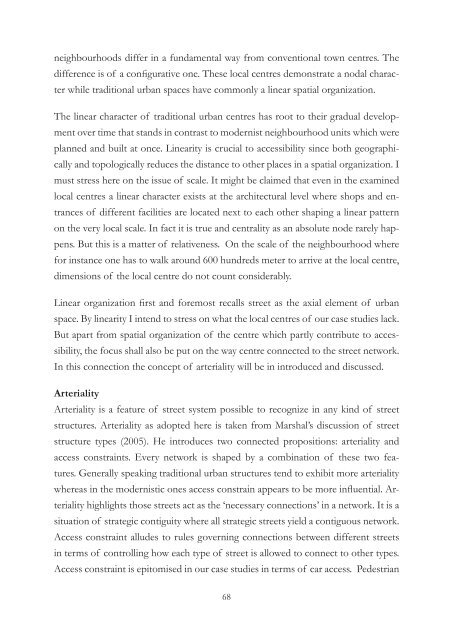Accessibility and Street Layout Exploring spatial equity in
Accessibility and Street Layout Exploring spatial equity in
Accessibility and Street Layout Exploring spatial equity in
Create successful ePaper yourself
Turn your PDF publications into a flip-book with our unique Google optimized e-Paper software.
neighbourhoods differ <strong>in</strong> a fundamental way from conventional town centres. The<br />
difference is of a configurative one. These local centres demonstrate a nodal character<br />
while traditional urban spaces have commonly a l<strong>in</strong>ear <strong>spatial</strong> organization.<br />
The l<strong>in</strong>ear character of traditional urban centres has root to their gradual development<br />
over time that st<strong>and</strong>s <strong>in</strong> contrast to modernist neighbourhood units which were<br />
planned <strong>and</strong> built at once. L<strong>in</strong>earity is crucial to accessibility s<strong>in</strong>ce both geographically<br />
<strong>and</strong> topologically reduces the distance to other places <strong>in</strong> a <strong>spatial</strong> organization. I<br />
must stress here on the issue of scale. It might be claimed that even <strong>in</strong> the exam<strong>in</strong>ed<br />
local centres a l<strong>in</strong>ear character exists at the architectural level where shops <strong>and</strong> entrances<br />
of different facilities are located next to each other shap<strong>in</strong>g a l<strong>in</strong>ear pattern<br />
on the very local scale. In fact it is true <strong>and</strong> centrality as an absolute node rarely happens.<br />
But this is a matter of relativeness. On the scale of the neighbourhood where<br />
for <strong>in</strong>stance one has to walk around 600 hundreds meter to arrive at the local centre,<br />
dimensions of the local centre do not count considerably.<br />
L<strong>in</strong>ear organization first <strong>and</strong> foremost recalls street as the axial element of urban<br />
space. By l<strong>in</strong>earity I <strong>in</strong>tend to stress on what the local centres of our case studies lack.<br />
But apart from <strong>spatial</strong> organization of the centre which partly contribute to accessibility,<br />
the focus shall also be put on the way centre connected to the street network.<br />
In this connection the concept of arteriality will be <strong>in</strong> <strong>in</strong>troduced <strong>and</strong> discussed.<br />
Arteriality<br />
Arteriality is a feature of street system possible to recognize <strong>in</strong> any k<strong>in</strong>d of street<br />
structures. Arteriality as adopted here is taken from Marshal’s discussion of street<br />
structure types (2005). He <strong>in</strong>troduces two connected propositions: arteriality <strong>and</strong><br />
access constra<strong>in</strong>ts. Every network is shaped by a comb<strong>in</strong>ation of these two features.<br />
Generally speak<strong>in</strong>g traditional urban structures tend to exhibit more arteriality<br />
whereas <strong>in</strong> the modernistic ones access constra<strong>in</strong> appears to be more <strong>in</strong>fluential. Arteriality<br />
highlights those streets act as the ‘necessary connections’ <strong>in</strong> a network. It is a<br />
situation of strategic contiguity where all strategic streets yield a contiguous network.<br />
Access constra<strong>in</strong>t alludes to rules govern<strong>in</strong>g connections between different streets<br />
<strong>in</strong> terms of controll<strong>in</strong>g how each type of street is allowed to connect to other types.<br />
Access constra<strong>in</strong>t is epitomised <strong>in</strong> our case studies <strong>in</strong> terms of car access. Pedestrian<br />
68

















